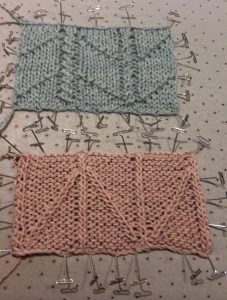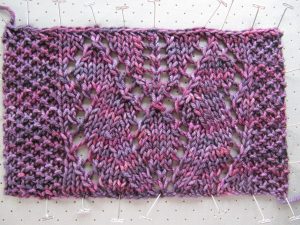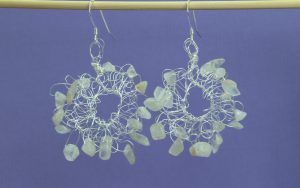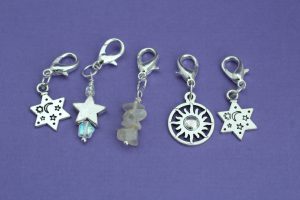
90% of all knitters have never swatched before they launch into making a garment. I just made that statistic up, but I imagine you have either said yourself, or heard a knitting friend say, “I can’t be bothered to knit a swatch, I’ll just knit the sweater/cardigan/hat and I’m sure it will be OK”. Perhaps it will be OK, perhaps it won’t. You may have the knack of matching, exactly, the gauge of the test knit garment, but it is highly unlikely.
What is Gauge?
Gauge is the tension used by the designer when knitting the test garment, using the yarn and needle sizes specified. It is the tension you need to match in order to obtain the correct size/fit for your garment from the instructions given in the pattern.
Gauge is usually measured over a square of knitted fabric just over 10cm (4inches) square. The pattern will tell you if this is measured over stocking stitch (stockinette) or garter stitch, or over a portion of the pattern such as a lace repeat. Ideally the swatch should be washed in the way recommended by the yarn manufacturer and blocked to size so that the number of stitches across and the number of rows down can be measured accurately for a 10cm square.
If, having knitted your swatch, washed it, blocked it and measured it, you find that you have too many stitches/rows in your sample you need to use a larger needle; go up half a millimetre and re-swatch. If you find you have too few stitches/rows in your first sample, then you need to go down a needle size and re-swatch.
Some Sums
The photograph above shows the difference a tiny 0.25mm needle change can have on a finished article. The top stocking stitch swatch was knitted on 3.75mm needles (the size recommended for the yarn) and the gauge I obtained was 20.5 stitches and 28 rows in a 10cm (4 inch) square, marked by the coloured threads. With the same yarn I went down a size to 3.5mm needles and my gauge was 22 stitches and 30 rows.
This may seem a fiddling small problem, but supposing you were knitting a sweater sized to be 50 inches around, using that yarn and 3.75mm needles, and the tension of the pattern says 22stsx30rows, but you are knitting at a tension of 20.5stsx28rows. For every 4 inches widthways you are knitting 1.5 stitches too many; that is 19 stitches too many in total on every row, or an additional 4 inches/10cm of fabric. For a loose garment you may be able to live with that, but for something that was meant to fit to the form, it would not work.
The length matters, too. This imaginary sweater may have a specific pattern that has been carefully constructed to require 300 rows, that is ten lots of 10cm/4inches/30rows. But your tension gives 28 rows to the 10cm, and so your garment, knitted to the pattern, will actually be the same number of rows but three inches longer than the pattern specifies.
And that is just with a difference in needle size of 0.25mm!
So overall, your lovely imaginary sweater is too large by a piece of fabric measuring 4 inches by 40 inches plus a piece of fabric measuring 54 inches by 3 inches; that is a lot of fabric and a lot of yarn to waste on a sweater that will not fit well when it is finished.
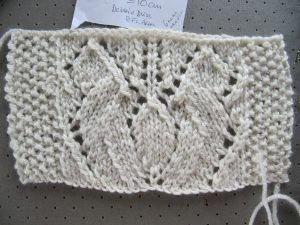
Alternatives to Swatching
Swatching and re-swatching takes time and yarn, and most knitters, having decided to knit something, want to get started. You may not have enough of a precious skein to knit a swatch as well as the garment; you may be constrained by time. Sometimes, knitting the first part (say, the welt and first part of the back of a sweater) is enough to give you an idea that you are on the right track with tension; it is not too much to have to unpick if the tension is out.
If you are knitting an item, such as a shawl, you can usually dispense with a swatch, as long as you are confident you have enough yarn to cover the eventuality that the finished item is larger than the pattern specifies. With items such as socks and hats, having an idea of your own tension using typical sock yarn or 4ply/fingering would be invaluable in ensuring a good fit. After all, you would not want to go to the trouble of knitting a Fair Isle Tam only to find that it is too tight to fit your head! Nor would you want to knit socks that bag at the ankles because your tension is not accurate.
Other reasons to Swatch

When designing a garment or item, swatching is essential to the process. Unless you are a very skilled and experienced designer, it is very difficult to picture a pattern written on paper as the finished article/edging/cuff/etc. A swatch immediately shows up any flaws or inconsistencies in the design.
Designing is a process of refining until the desired effect is reached. This involves a lot of drawing, experimenting and swatching, and is rarely achieved by simply picking up needles and yarn and casting on. The next time you buy a pattern for a beautiful shawl, with a complex and challenging pattern, you can be sure that the designer spent months and months drawing and swatching, charting and reswatching, until s/he was heartily sick of the pattern!
So my advice to knitters is, bite the bullet and swatch. It may take you a couple of hours and an extra ball of yarn, but the finished results will be worth it.
